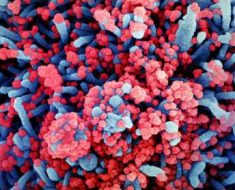A recent study posted to the bioRxiv*preprint server described rapid mutagenesis and rescue of severe acute respiratory syndrome coronavirus 2 (SARS-CoV-2) variants without cloning, using a novel reverse genetics strategy.
 Study: Rapid cloning-free mutagenesis of new SARS-CoV-2 variants using a novel reverse genetics platform. Image Credit: kentoh/Shutterstock.com
Study: Rapid cloning-free mutagenesis of new SARS-CoV-2 variants using a novel reverse genetics platform. Image Credit: kentoh/Shutterstock.com

 *Important notice: bioRxiv publishes preliminary scientific reports that are not peer-reviewed and, therefore, should not be regarded as conclusive, guide clinical practice/health-related behavior, or treated as established information.
*Important notice: bioRxiv publishes preliminary scientific reports that are not peer-reviewed and, therefore, should not be regarded as conclusive, guide clinical practice/health-related behavior, or treated as established information.
Background
Established reverse genetics methods for CoVs were adapted to SARS-CoV-2 after its emergence. A DNA-based method, infectious subgenomic amplicons (ISA), allows the recombination of transfected overlapping DNA fragments into a full-length genome, which was recently adapted to SARS-CoV-2.
The study and findings
In the present study, researchers developed and described an ISA-based strategy termed ‘cloning-free and exchangeable system for virus engineering and rescue’ (CLEVER), using SARS-CoV-2.
Eight overlapping SARS-CoV-2 genomic fragments were amplified and transfected into HEK293T cells. The resultant propagation of the recombinant virus (rCOV2) was assessed by observing the cytopathic effect (CPE).
The team observed the first CPE five to eight days post-transfection (DPT). They did not observe any improvements in virus recovery with co-transfection of nucleotide-expressing plasmid or messenger RNA (mRNA). Further, as optimization, the fragments were reduced from eight to four.
One virus-producing cell per 11,000 cells was observed by transfecting four fragments, compared to one in 160,000 cells for eight-fragment transfection.
Additionally, the team tested the impact of transfection using four fragments on reconstitution fidelity by comparing replication competence between wild-type isolates and recombinant viruses. The size and shape of the wild-type virus and rCOV2 generated from four fragments (rCOV2-4fr) were similar.
Although replication kinetics of rCOV2-4fr revealed reduced titers within 24 hours post-infection, titers were comparable after prolonged infection. Transmission electron microscopy was used to compare virion integrity. rCOV2-4fr was indistinguishable from the wild-type virus.
The team indicated that the reconstitution process was reproducible, with successful virus recovery from HEK293, HEK293T, BHK-21, and CHO cell lines.
Next, the team optimized the amplification process by adopting some rules, such as using high template input or a high-fidelity polymerase, restricting amplification cycles to 25, and pooling eight parallel amplification reactions.
The researchers introduced a genetic marker (Sal I recognition) site to differentiate recombinant viruses from accidental contamination with clinical isolates. This marker was present in all reconstituted viruses.
Moreover, the team introduced the spike gene sequence of SARS-CoV-2 variants while keeping/retaining the remaining ancestral (Wuhan) strain sequence as the background.
The target sequence (variant spike gene) was amplified using commercial or in-house plasmids. Chimeric viral particles were rescued and confirmed by sequencing.
Rescued chimeric viruses or clinical isolates of the Wuhan strain and the Omicron BA.1 or BA.5 variants were subjected to serum samples from vaccinated individuals. The highest neutralization titers were against the Wuhan strain. Titers were similar between chimeric viruses and their respective spike homologs.
The amplification step could be exploited for mutagenesis without de novo synthesis or cloning. The team designed an oligonucleotide pair that introduced N501Y or G614D. The fragments harboring these point mutations were co-transfected with other fragments required for genome assembly.
Sequencing confirmed the successful introduction of substitutions. Further, they designed oligonucleotide primers to delete ORF3a, which was confirmed by sequencing and immunoblot.
Besides, the team successfully introduced a site-specific foreign sequence (triple FLAG tag) near the carboxy end of ORF8. Further, the researchers slightly tweaked the strategy to rescue rCOV2 from clinical isolates directly.
They cloned eucaryotic expression elements required for DNA-dependent transcription of the viral genome or commercially obtained custom plasmids encoding these elements. All elements were assembled into a single linker DNA.
One hundred base pairs of viral 3’ and 5’ untranslated regions (UTRs) flanked the linker fragment on either side. It was designed for successful recombination into a circular DNA product. Eight SARS-CoV-2 genomic fragments were amplified in a single step from the viral RNA. The amplicons were co-transfected with the linker fragment. Viable viruses were rescued on seven DPT.
This allowed the rescue of different chimeric viruses without bacterial cloning. Genomes of clinical isolates of the SARS-CoV-2 Wuhan strain and the Omicron variants (BA.1 and BA.5) were amplified.
The spike gene-containing fragment was exchanged with corresponding fragments carrying variant spike gene(s). Consequently, chimeric viruses carrying heterologous spike genes were generated.
Finally, the team rescued a recombinant virus from a clinical isolate of Omicron BA.5 as described earlier, but with primers introducing the ORF3a deletion. Similarly, recombinant XBB.1.5 with ORF3a deletion was rescued. Thus, the authors could generate deletion mutants of emerging SARS-CoV-2 variants in a single step.
Conclusions
In summary, the CLEVER approach was highly versatile with broad application for rapid mutagenesis or rescue of SARS-CoV-2 without cloning. The authors demonstrated the flexibility of this technique by introducing point mutations, foreign sequences, or ORF3a deletion.
Furthermore, by intracellular circularization using the linker fragment, they introduced ORF3a deletion and rescued functional recombinant viruses in a single step from viral RNA.

 *Important notice: bioRxiv publishes preliminary scientific reports that are not peer-reviewed and, therefore, should not be regarded as conclusive, guide clinical practice/health-related behavior, or treated as established information.
*Important notice: bioRxiv publishes preliminary scientific reports that are not peer-reviewed and, therefore, should not be regarded as conclusive, guide clinical practice/health-related behavior, or treated as established information.
- Preliminary scientific report.
Kipfer, E. et al. (2023) "Rapid cloning-free mutagenesis of new SARS-CoV-2 variants using a novel reverse genetics platform". bioRxiv. doi: 10.1101/2023.05.11.540343. https://www.biorxiv.org/content/10.1101/2023.05.11.540343v1
Posted in: Device / Technology News | Medical Science News | Medical Research News | Disease/Infection News
Tags: Cell, Cloning, Contamination, Coronavirus, Coronavirus Disease COVID-19, DNA, Electron, Electron Microscopy, Gene, Genes, Genetic, Genetics, Genome, Genomic, Intracellular, Microscopy, Nucleotide, Oligonucleotide, Omicron, Plasmid, Polymerase, Propagation, Respiratory, RNA, SARS, SARS-CoV-2, Severe Acute Respiratory, Severe Acute Respiratory Syndrome, Syndrome, Transcription, Transfection, Virus

Written by
Tarun Sai Lomte
Tarun is a writer based in Hyderabad, India. He has a Master’s degree in Biotechnology from the University of Hyderabad and is enthusiastic about scientific research. He enjoys reading research papers and literature reviews and is passionate about writing.
Source: Read Full Article





